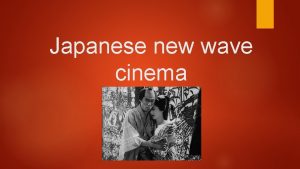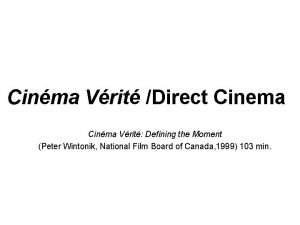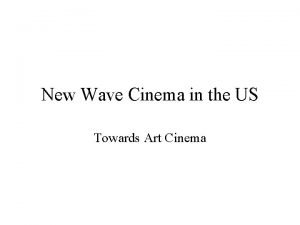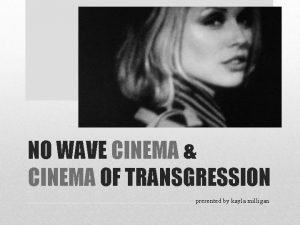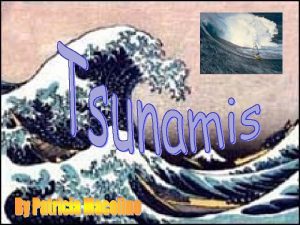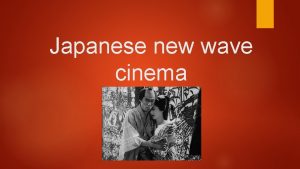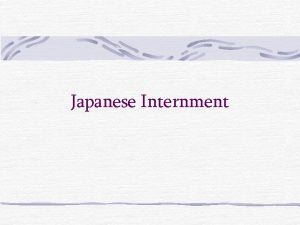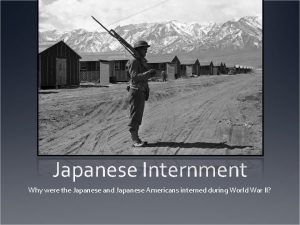Japanese new wave cinema What is Japanese new











- Slides: 11

Japanese new wave cinema

What is Japanese new wave? The Japanese new wave movement initially began within the studios - with young, and previously little-known filmmakers. It brought about the creative revitalization of Japanese cinema in the 1960 s —even if the term itself was borrowed from the concurrent movement happening in France. This movement was focused on exploring a number of ideas previously not often seen in more traditional Japanese cinema: social outcasts as protagonists (including criminals or delinquents), uninhibited sexuality, changing roles of women in society, racism and the position of ethnic minorities in Japan, and the critique of (or deconstruction of) social structures and assumptions.

Directors of the movement Some directors initially associated with the Japanese New Wave included Hiroshi Teshigahara, Nagisa Oshima, Yoshishige Yoshida, Shohei Imamura, Ko Nakahira and Seijun Suzuki.

French new wave French New Wave Film-makers wanted to create a personal kind of cinema expressing life experiences and philosophies of the 50 s and 60 s, how life had changed post-WW 2. Japanese directors drew inspiration from the rebellious film movement that was becoming immensely popular in France. New Wave wanted to use playful and unique techniques to experiment with supra-realism, to engage the audience’s perspective realisms in a new way. Came up with the auteur theory. Came from the directors. Anti-hollywood

French new wave directors The directors associated with the Nouvelle Vague, include Francois Truffaut, Jean-Luc Godard, Claude Chabrol, Eric Rohmer, Jacques Rivette, Louis Malle, Alain Resnais, Agnes Varda and Jacques Demy have made, between them, films numbering in the many hundreds. Known as the Nouvelle Vague.

Techniques The ‘taboo’ themes in the movies are shown in a vast array different ‘rulebreaking’ techniques, through editing, camera movements and even breaking the fourth wall, encompassing a very self-aware supra-realist style of filmmaking. They wanted to show things could be done differently, but still to full effect and did this by rebelling against any conventional film making techniques.

The scripts (or lack thereof) of these new directors were often revolutionary, but the films' modest budgets often forced them to become technically inventive as well. As a result, the movies of the new wave have become known for certain stylistic innovations such as: jump cuts (a non-naturalistic edit), rapid editing, shooting outdoors and on location, natural lighting, improvised dialogue and plotting, direct sound recording (as opposed to the dubbing that was popular at the time), mobile cameras, and long takes. In addition, their films often engaged, although sometimes indirectly, with the social and political upheavals of their times.

Other techniques Editing techniques such as random transitioning from black and white to colour. The shot angles rarely depended on high or low angle shots, relying on neutral ones instead. This conforms to the New Wave conventions by giving the illusion of inconspicuousness, connoting Japan’s stability at the time. However, the characters’ morals and intentions often undermine this sense of stability, which is presumably the effect the Japanese New Wave filmmakers wished to achieve.


• The rebelliousness of the movement was also paralleled with the introduction of onscreen kissing and the like and these scenes were further foregrounded with the use of close-ups and occasionally extreme close-ups.

Effect on audiences *The unorthodox ideologies of the Japanese New Wave attracted an audience of youth and the middle-class community. With the growing popularity of television in the sixties, the female audience of cinema, who often fell victim to the temptation of watching television, began to dwindle, forcing directors to rethink their direction. By introducing themes that made audiences question their own societies and realisms, the movement has left a hugely influential stamp in widening the progressiveness of today’s conventional cinema and the attitude of its viewers.
 New wave japanese cinema
New wave japanese cinema La vrit
La vrit The american new wave
The american new wave Marquee cinema new hartford new york
Marquee cinema new hartford new york Cinema in japanese hiragana
Cinema in japanese hiragana Blessed transgression! film
Blessed transgression! film Tsunami is japanese word
Tsunami is japanese word Longitudinal vs transverse wave
Longitudinal vs transverse wave Long waves and short waves
Long waves and short waves Difference between full wave and half wave rectifier
Difference between full wave and half wave rectifier Longitudinal vs transverse waves
Longitudinal vs transverse waves Half wave rectifier definition
Half wave rectifier definition
